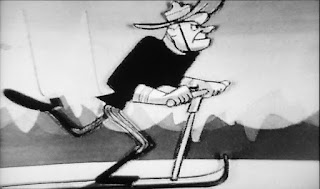 |
| Model sheet by director Pete Burness |
If you've read either Keith Scott's
The Moose That Roared or my book,
The Art of Jay Ward Productions, you know that the Dudley Do-right we're all familiar with didn't spring fully formed on
The Bullwinkle Show but had his origins in 1948 when Jay Ward and Alex Anderson teamed up to produce the first nationally broadcast animated television series,
Crusader Rabbit.
Crusader was only one of three proposed series, the other two being
Hamhock Jones, a Sherlock Holmes parody, and
Dudley Doright of the Mounties, a parody of the Nelson Eddy/Jeanette McDonald filmed operetta,
Rose-Marie, and classic melodramas. Hamhock was destined to be a footnote in animation history but Jay Ward revived Dudley 13 years later with a tremendous assist from designer Al Shean and writers Chris Hayward and Lloyd Turner.
Ward and Anderson produced pilots for all three series, which consisted of Alex Anderson's drawings "animated" with camera movement on the still artwork and using a much slower narrator (
Crusader Rabbit's Roy Whaley) than the later series. The basic formula was established with the stereotypical melodramatic villain, here known as Sydney "The Snake" Snodgrass, the sweet heroine, Bess Blushmore, and the hero, Dudley Doright, a member of the Royal Canadian Mounted Police. Only Dudley retained his name, the other two became Snidely Whiplash and Nell Fenwick. The pilot was set in Deepfreeze Landing and the story unfolded in rhyme, as if from Robert W. Service's classic poem, "The Shooting of Dan McGrew." Here, a very rare peak at some images from the lost Dudley Doright pilot:
 |
| That beer drinking, pistol shooting bad guy, Sydney "The Snake" Snodgrass. |
|
|
 |
| The demure Bess Blushmore, patterned after Preston Blair's Red Hot Riding Hood. |
|
 |
| No good can come of this; Sydney introduces himself to Bess. |
 |
| Dudley Doright on the lookout for bad guys. |
 |
Somehow, a slide whistle figures into the plot.
|
 |
| Dudley Doright of the Mounties to the rescue. |
 |
| Inspector Fenwick was never part of the original concept. |
The pilot was produced as a cliffhanger, leaving the ending up to potential sponsors of the show. The real outcome wouldn't be revealed for 13 years, when Dudley ended up with his own series on 1961's
The Bullwinkle Show, replacing
Peabody's Improbable History.
 |
| Neither was Dudley's horse, Horse. |
Chris Hayward and Lloyd Turner took Anderson's concept over the top, turning it from an adventure series into a parody of an adventure series while Jay Ward's ace designer, Al Shean, re-imagined the characters in his own inimitable style.
 |
| These last three model sheets by Al Shean. |
To read more about Dudley's origin and how it came to be one of the best of all of Ward's shows, check out
The Moose That Roared and/or
The Art of Jay Ward Productions. The latter can be purchased for half off Amazon's list price at
artofjayward.com.





















































